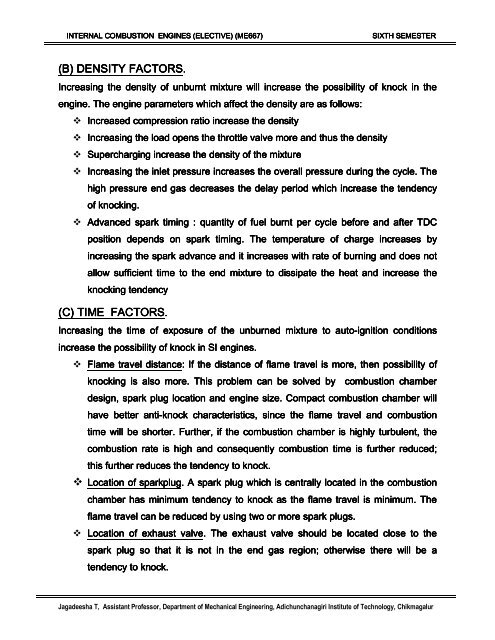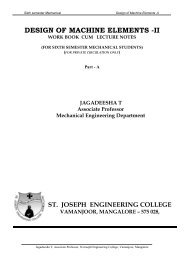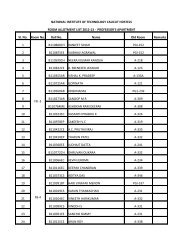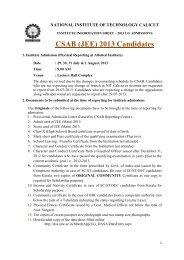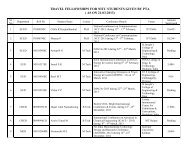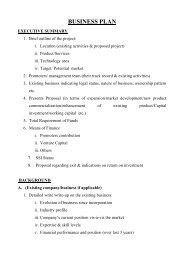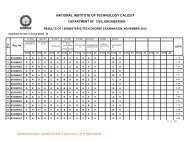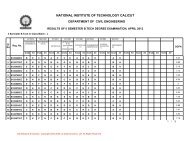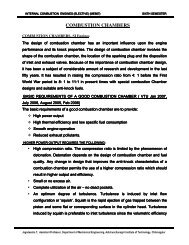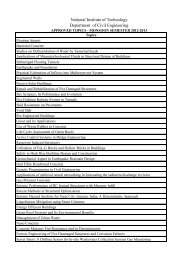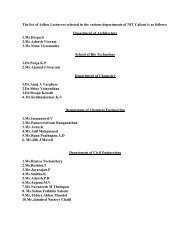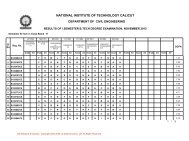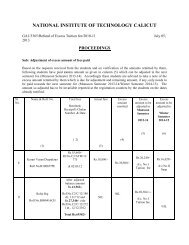combustion process in si engines - National Institute of Technology
combustion process in si engines - National Institute of Technology
combustion process in si engines - National Institute of Technology
Create successful ePaper yourself
Turn your PDF publications into a flip-book with our unique Google optimized e-Paper software.
INTERNAL COMBUSTION ENGINES (ELECTIVE) (ME667)<br />
SIXTH SEMESTER<br />
(B) DENSITY FACTORS.<br />
Increas<strong>in</strong>g the den<strong>si</strong>ty <strong>of</strong> unburnt mixture will <strong>in</strong>crease the pos<strong>si</strong>bility <strong>of</strong> knock <strong>in</strong> the<br />
eng<strong>in</strong>e. The eng<strong>in</strong>e parameters which affect the den<strong>si</strong>ty are as follows:<br />
Increased compres<strong>si</strong>on ratio <strong>in</strong>crease the den<strong>si</strong>ty<br />
Increas<strong>in</strong>g the load opens the throttle valve more and thus the den<strong>si</strong>ty<br />
Supercharg<strong>in</strong>g <strong>in</strong>crease the den<strong>si</strong>ty <strong>of</strong> the mixture<br />
Increas<strong>in</strong>g the <strong>in</strong>let pressure <strong>in</strong>creases the overall pressure dur<strong>in</strong>g the cycle. The<br />
high pressure end gas decreases the delay period which <strong>in</strong>crease the t<br />
tendency<br />
<strong>of</strong> knock<strong>in</strong>g.<br />
Advanced spark tim<strong>in</strong>g : quantity <strong>of</strong> fuel burnt per cycle before and after TDC<br />
po<strong>si</strong>tion depends on spark tim<strong>in</strong>g. The temperature <strong>of</strong> charge <strong>in</strong>creases by<br />
<strong>in</strong>creas<strong>in</strong>g the spark advance and it <strong>in</strong>creases with rate <strong>of</strong> burn<strong>in</strong>g and does not<br />
allow sufficient time to the end mixture to dis<strong>si</strong>pate the heat and <strong>in</strong>crease the<br />
knock<strong>in</strong>g tendency<br />
(C) TIME FACTORS.<br />
Increas<strong>in</strong>g the time <strong>of</strong> exposure <strong>of</strong> the unburned mixture to auto-ignition conditions<br />
<strong>in</strong>crease the pos<strong>si</strong>bility <strong>of</strong> knock <strong>in</strong> SI eng<strong>in</strong>es.<br />
Flame travel distance: : If the distance <strong>of</strong> flame travel is more, then pos<strong>si</strong>bility <strong>of</strong><br />
knock<strong>in</strong>g is also more. This problem can be solved by <strong>combustion</strong> chamber<br />
de<strong>si</strong>gn, spark plug location and eng<strong>in</strong>e <strong>si</strong>ze. Compact <strong>combustion</strong> chamber will<br />
have better anti-knock characteristics, s<strong>in</strong>ce the flame travel and <strong>combustion</strong><br />
time will be shorter. Further, if the <strong>combustion</strong> chamber is highly turbulent, the<br />
<strong>combustion</strong> rate is high and consequently <strong>combustion</strong> time is further reduced;<br />
this further reduces the tendency to knock.<br />
Location <strong>of</strong> sparkplug. . A spark plug which is centrally located <strong>in</strong> the <strong>combustion</strong><br />
chamber has m<strong>in</strong>imum tendency to knock as the flame travel is m<strong>in</strong>imum. The<br />
flame travel can be reduced by us<strong>in</strong>g two or more spark plugs.<br />
Location <strong>of</strong> exhaust valve. . The exhaust valve v<br />
should be located close to the<br />
spark plug so that it is not <strong>in</strong> the end gas region; ; otherwise there will be a<br />
tendency to knock.<br />
Jagadeesha T, As<strong>si</strong>stant Pr<strong>of</strong>essor, Department <strong>of</strong> Mechanical Eng<strong>in</strong>eer<strong>in</strong>g, Adichunchanagiri <strong>Institute</strong> <strong>of</strong> <strong>Technology</strong>, Chikmagalur


